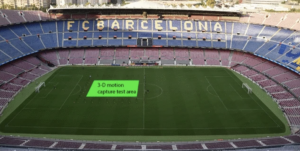Technology is changing football analysis. Most professional football clubs now employ electronic performance and tracking systems (EPTS) to track player movements. EPTS devices track data such as player position, player velocity, player acceleration, ball position, and distance covered. Analysis of this information helps football clubs improve team performance.
There are 3 main types of EPTS systems: optical-based camera systems, local positioning systems (LPS), and global navigation satellite systems (GNSS). New EPTS devices need to be independently evaluated to validate marketed accuracies. One way to evaluate an EPTS system is by validating it against other tracking systems.
3D motion capture systems are commonly used to validate EPTS devices. Within small areas, 3D motion capture systems are very accurate, producing sub-millimeter errors. However, 3D motion capture systems have a limitation: they cannot track the entirety of a football pitch. This is because 3D motion capture cameras have weak depths of field.
In a recent study, Dr. Robert J. Aughey and colleagues proposed a hybrid system combining a 3D motion capture system, Vicon, with a computer vision system, VisionKit, to better validate EPTS devices. VisionKit can be deployed to selected areas within a football pitch, helping cover an entire football pitch in conjunction with Vicon.
60 footballers were recruited to participate in activities such as a 20-meter sprint and a 2v2 game. These common football activities were confined within a 30 m × 30 m section of a football field. Within this section, player movements were tracked both with the Vicon 3D motion capture system and the VisionKit computer vision system.

The researchers found that the computer vision system had a strong agreement with the 3D motion capture system in measuring player speed and player position. The VisionKit system was able to track activities such as “high-speed movements, rapid changes of direction and speed, and potential for occlusion with multiple participants moving in the test area.” The root mean square deviation for player speed was 0.04 m/s and the root mean square deviation for player position was 0.18 m. These results are acceptable for tracking the speed and position of players.
Overall, this study demonstrates that VisionKit, either in conjunction with Vicon or by itself, may be used to accurately validate the performance of EPTS devices.
Image was obtained from the mentioned paper authored by Dr. Robert J. Aughey and colleagues (article is open access and licensed under a Creative Commons Attribution 4.0 International License)